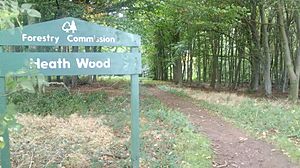Heath Wood barrow cemetery facts for kids
Quick facts for kids Heath Wood barrow cemetery |
|
|---|---|

The south-east entrance to Heath Wood
|
|
| Location | Ingleby, Derbyshire |
| Built | 9th Century AD |
Heath Wood barrow cemetery is a special Viking burial ground located near Ingleby, Derbyshire, in England. It's a very important historical site because it's the only known place in the British Isles where Vikings cremated (burned) their dead. This cemetery helps us learn more about the Viking Age in England.
Contents
What is Heath Wood?
Heath Wood is home to 59 barrows, which are mounds of earth built over graves. These barrows are part of a Viking burial site. It's thought that this cemetery was used by the Viking Great Army. This was a large group of Viking warriors who came to England between 873 and 878 A.D.
Viking Burials and Cremation
What makes Heath Wood so unique is that the Vikings here cremated their dead. This means they burned the bodies before burying them. Most Viking burials found in Britain are not cremations, which makes Heath Wood a very rare discovery.
In 1855, an early explorer named Thomas Bateman dug into some of these mounds. He found that some of them were empty. These empty mounds are called cenotaphs. A cenotaph is a monument built to honor someone whose body is not present. Perhaps the bodies of these Vikings were lost in battle or buried elsewhere.
Discoveries at Heath Wood
More recently, between 1998 and 2000, new excavations took place at Heath Wood. These digs uncovered many interesting items. These finds are now on display at the Derby Museum.
The items found at Heath Wood are from the same time period as other Viking burials discovered nearby in Repton. However, the burials in Repton were not cremations. This difference helps historians understand the different burial practices of the Vikings.
Protecting Heath Wood
Heath Wood is a very important historical site, so it is protected by law. It is officially known as a "Scheduled Ancient Monument" and is listed as "Derbyshire 101." This means it's a special place that needs to be preserved for future generations to study and learn from.
The land where Heath Wood is located is currently managed by the Forestry Commission. This group helps to look after forests and woodlands in England.
The Path Through the Wood
There is a path that goes through Heath Wood. This path connects two old properties, Foremarke Hall and Knowle Hill, which used to belong to the Burdett family. The path was likely used by the family to visit St Saviour's church, which they built in 1662.
Interestingly, in the 1700s, Heath Wood was actually an open field, not a forest. The trees have grown there since then. If the woods weren't there, the burial site would have had an amazing view of the Trent valley. The path was carefully planned so that it doesn't disturb any of the ancient burial mounds.
Images for kids




